With World 1-3 bested, Pit moves along to an even more advanced version of the vertically scrolling action that’s transpired over the past three stages… oh, no, wait. Actually World 1-4 bears no resemblance whatsoever to the previous three levels. Instead of a one-way ascent, this stage instead plays out as a labyrinth of single, interconnected screens.
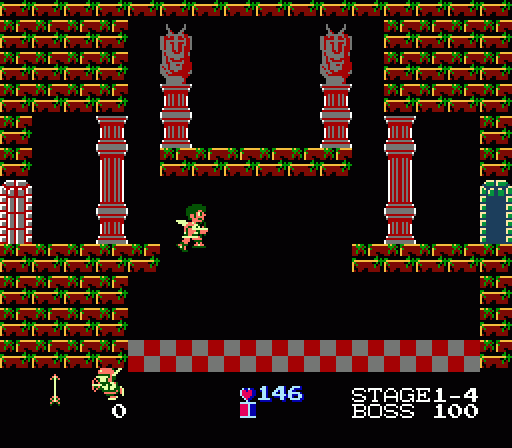
The x-4 stages, in my opinion, are the saving grace of Kid Icarus. They change up the experience considerably, briefly turning the adventure into something more akin to a Zelda or Metroid game than the one-way sidescroller that it otherwise resembles. These stages can be challenging, but the challenge is generally less one-slip-and-you’re-dead nasty than the standard levels. On the contrary, you can’t actually die from falling in one of the labyrinth stages, as none of the screens here are “bottomless” — in proper Metroid style, this stage has a fixed base level, and dropping through the bottom of one screen simply leads you to the next.
Because you can scroll freely throughout this stage, World 1-4 switches up certain play mechanics. For starters, you can farm enemies for points and cash, because they respawn infinitely if you leave a room and quickly return. Certain rooms have enemies that drop large hearts (the ones with a value of 10) and take only a single shot with a level two arrow to kill, which means there’s really no reason not to max out your cash and take the time to earn your next health upgrade. Similarly, the shops located here aren’t single-use locations, either. While you can buy only one item per visit, you can simply duck out and back in again to reset the inventory. You can reload your health (though there’s a pool at the lower left of the map, opposite the boss, that will restore your energy for free) and stock up on stuff like Feathers and Waters of Life.
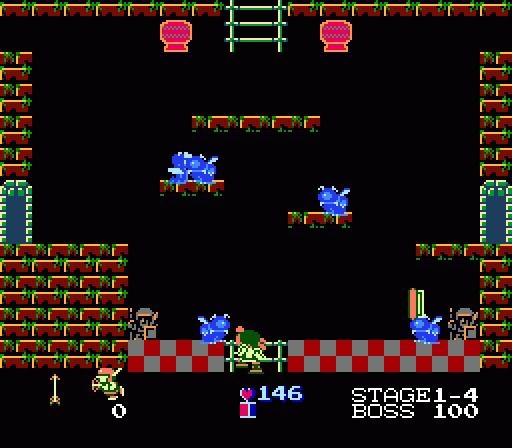
The shops here also offer a couple of unique items: The pencil and the torch. These aren’t much use on their own, but if you buy them after collecting the map located in a room near the beginning, you can switch to the sub-screen and chart your progress through the maze. The pencil marks explored rooms on the map, while the torch shows your current location. It’s a simple, Zelda-style map, so it doesn’t show one-way passages (that is, ladders too high to reach again if you drop from another room), but it helps.
The mallets you’ve been collecting after snagging harps come into play in this stage, too. They work as a sort of “alternate fire” mode, replacing your arrows with a press of the Select button. They’re no good against enemies, but if you hit one of the little centurion statues that appear throughout the labyrinth with a hammer, it will free a soldier from Medusa’s curse to join you in the boss fight. They’re only good for one hit, but they can briefly increase your firepower, which can be very useful in a pinch.
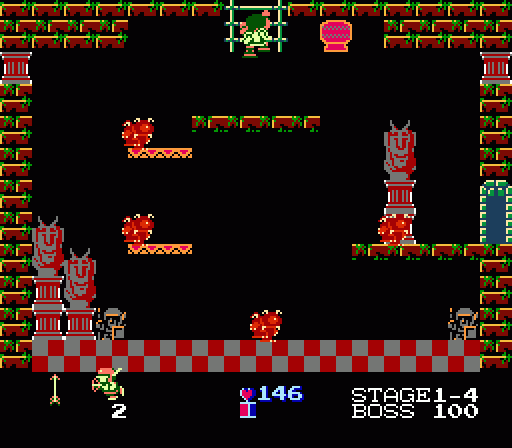
Of course, the most infamous element of the labyrinth stages is the dreaded Eggplant Wizard. They’re the worst. The worst.
Eggplant Wizards, as their name suggests, look like eggplants. And they chuck eggplants in an arc. Weird, right? Someone at Nintendo seemed to have an eggplant obsession back then, since eggplants appear in several of their early NES games (this, Wrecking Crew, and Ice Climber come immediately to mind). This would be harmless and amusing except for the fact that if one of those eggplants strikes Pit, he’s rendered completely helpless: His upper body is transformed into a giant eggplant running around on angel legs.
It’s really bizarre, but the strangeness of it is overmatched by how annoying it is. Pit can run and jump and climb ladders in eggplant form, but that’s it. He can’t attack, which means that if you happen to wander into the boss’ lair while eggplanted, you’re completely screwed as the eggplant condition doesn’t wear off naturally and there are no consumable remedies for the curse. Instead, you have to locate a clinic, where a friendly nurse (who evidently has taken up residence in the maze to help eggplanted adventurers) will restore Pit’s proper body.
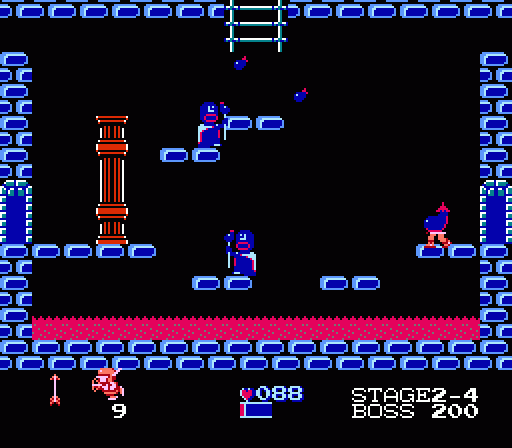
It’s an interesting challenge, and a very unique one, but as with many elements of Kid Icarus it doesn’t quite work as smoothly as one might hope. Being forced to run helplessly through the maze — sometimes through passages that make it impossible to leap safely over an enemy — in order to cure the condition sucks, especially in light of the fact that the clinic is so remote (occupying the otherwise useless upper-right area of the maze). Worse, one room places its Eggplant Wizards in such a way that you can’t really avoid their projectiles if they decide to throw them a certain way. You can only enter the room from above, and there’s a 50 percent chance that the two Wizards will toss their eggplants in an arc that hits Pit within a split-second of entering the room, impossible to avoid. Infuriatingly, this is the one room that links the upper portion of the maze to the lowest level where the boss awaits, so you don’t have a choice about entering this room. Basically, advancing to the boss is a crapshoot: Will the game dick you over this time or not?
It’s a shame about the unfairness of the Eggplant Wizards, because otherwise these levels are pretty great. Even the wizards themselves are an interesting and unique hazards; if they were used a little more intelligently, and if the eggplant status weren’t permanent, this stage would be a slam dunk.
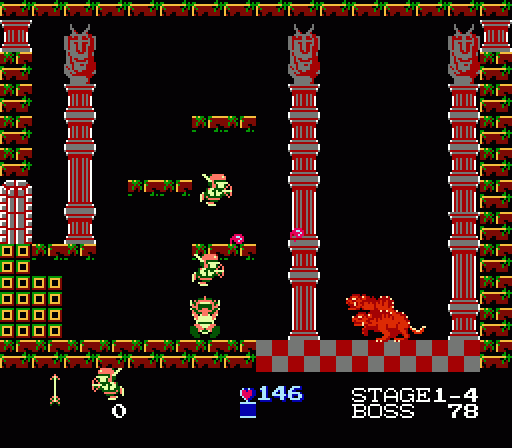
Thankfully, once you do reach the boss, he’s quite a pushover. He starts from the lower right and advances to the left slowly, occasionally belching simultaneous flames straight ahead and at a 45-degree angle. When he reaches the left side of the screen, he leaps up to the upper level and then runs back over to the right. He has 100 points of health, so if you’ve collected a power upgrade you need to shoot him 50 times. The centurions help a lot here — every time you shoot, they do too, and they inflict just as much damage on Twinbellows as your own arrows. They tend to hover in a way that blocks Pit from Twinbellow’s flames, too, so they can greatly extend your life. When you defeat Twinbellows, you acquire a special treasure that remains sealed until the very final stage and move along to World 2.
Incidentally, “Twinbellows” is either a really clever localization or a remarkably happy accident of localization. His name in Japanese is written as “Tsuinberos,” or “Twinberos,” suggesting he’s meant to be a two-headed version of Cerberus (whose name is written as “Kerberos” in Japanese — or “Kelbeross,” if you’re the guy writing the Ninja Gaiden manual). But of course a bellows is also a device that stokes a furnace, which means that “Twinbellows” actually works remarkably well… maybe even better than “Twinberus” might have. I’d like to say, “Nicely done, Nintendo localizers from the 1980s!” but these are the same guys who took a slightly modified version of the Japanese spelling of “hydra” (hyuudraw) and rendered it as the nonsensical “Hewdraw.” So, whatever.
Really enjoying this series, Jeremy - keep up the great work!
Just wanted to add a comment about the music for this level. It’s a beautiful, haunting piece…albeit a bit short/repetitive. For me, it brings back memories of playing this game in my basement as a kid growing up, lights low, a little freaked out by the thought of being turned into an eggplant.
This game. Oooh, this goddamned game. I was expecting something more free-form and forgiving, like Metroid or even Super Mario 2, but it falls far short of that mark. Every time I try to give it another chance, I just walk away annoyed. (Was the GameBoy sequel any better?)
I’m going with fluke on that translation. They obviously got the “Twin” part right, and probably figured the end bit was gibberish. R & L being interchangeable, they translated it as “Twinbelos” and then cleaned up “belos” to “bellows.”
Nice title for this section, Theseus so needs a game of his own. . .